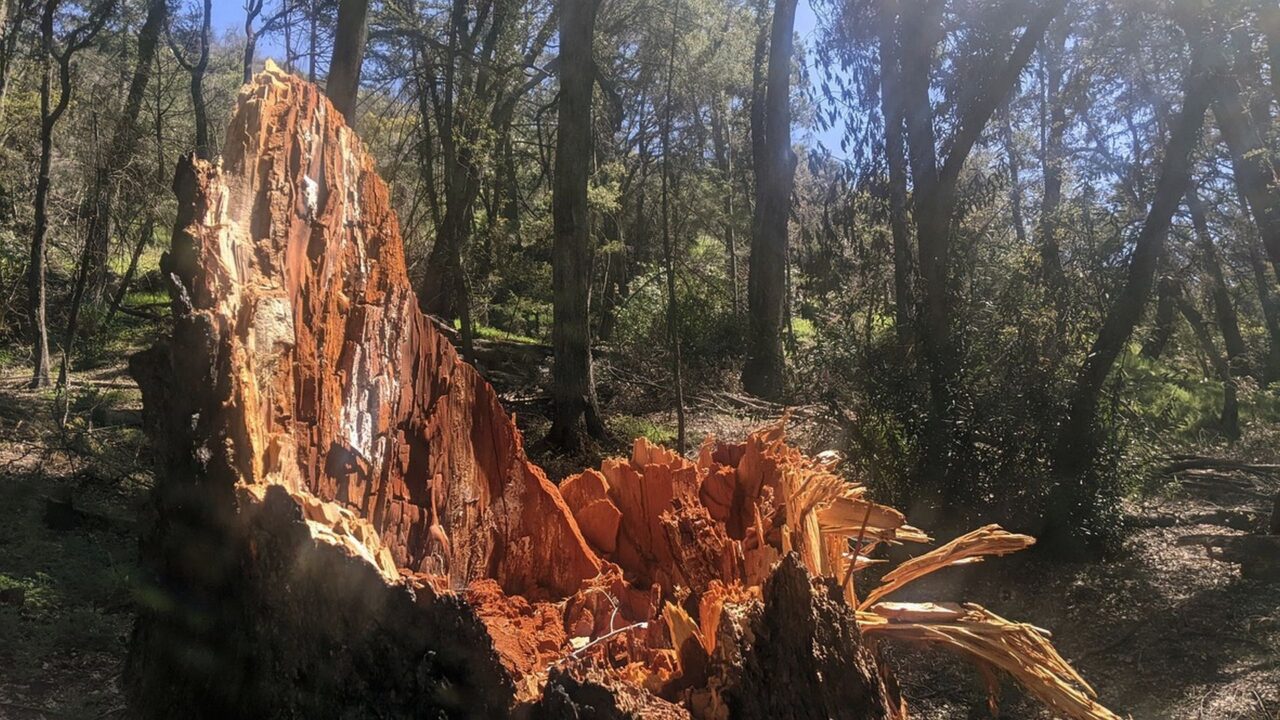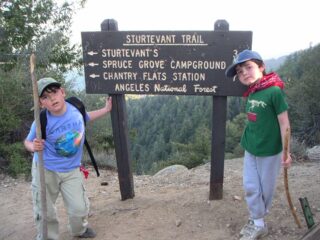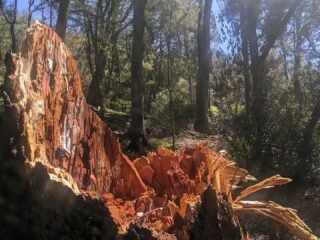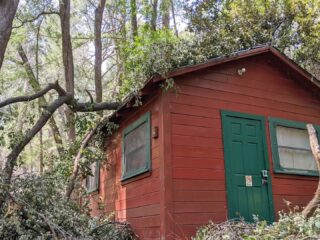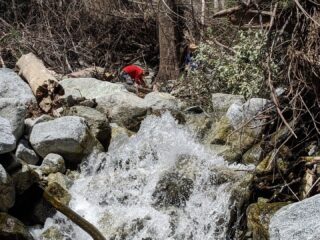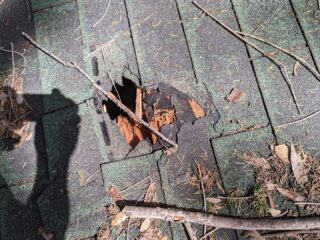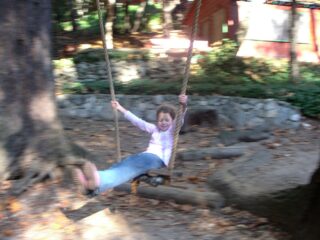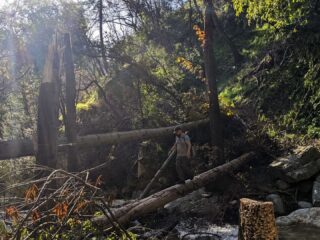Old News Is No News: Closed
The U.S. Forest Service has extended the Bobcat Fire closure for the Big Santa Anita Canyon. After the fire in September 2020, the original closure went into effect through April 1, 2021, when it was renewed for another year—when it was renewed again.
That put all eyes on this April 1, 2023 as the latest possibility for a change. Most other areas of the closure in the Angeles National Forest have re-opened, but the deep recesses of the Big Santa Anita have not recovered from the on-going after-effects of the fire, especially the record-breaking 2022-23 “atmospheric rivers”. Most of the trails remain inhospitable to public use, ranging from annoying to hazardous to impassable. Because the Canyon connects so many of those, closing the Canyon is the most effective way to maintain safety for now.
So, the USFS has extended the closure order – but this time by one month, and again for another month to allow time for further assessment. If extended again on June 1st for another month, that could become the pattern, or it could be extended through another season of winter rains all the way to spring of 2024. This would match the original estimates of a 3-5 year period of recovery.
The Trail Ahead
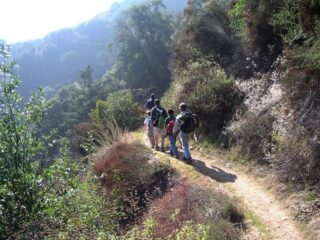
In the judgement of the Conservancy’s Board, keeping the Canyon closed to the general public is best – for now: the trails are truly not safe for typical day hikers, nor is the pack trail passable for the burros above Fern Lodge to Sturtevant Camp. But everyone is partnering to fix that as soon as possible.
Instead, the real concern is how the eventual re-opening will be managed. A preview of what that could look like was the first wave of the Covid pandemic in the spring-summer of 2020, when the Canyon was overwhelmed by people seeking to get outdoors. Whenever the Chantry Flat Road gate re-opens, the Canyon and Camp will need to brace for a similar onslaught of post-fire curiosity-seekers and wilderness-lovers eager to reconnect with one of the most accessible and popular trail networks of the San Gabriels.
Between now and then, the Conservancy will press forward on two tracks: repairing and renewing the Camp to host the public, and partnering in getting the trails up to spec for the burros—because if the (main) trail is good enough for the pack train, it’s good enough for the people!
To that end, the Conservancy will host a few overnight work weekends this summer: to sign-up to volunteer and get information got to sturtevantcamp.com/volunteer; to donate toward materials and repairs, go to sturtevantcamp.com/support.
And to stay up to date, check back here plus tag into our pages on Facebook, both the Sturtevant Camp and Wilbur Sturtevant.
Purpose: A Place for People
The annual meeting of the Board in January included adoption of freshly detailed Bylaws. Those familiar with such documents would recognize the usual lingo for an organization, like setting the officers and electing members. But all of it rests upon the second Article, “Purpose of the Conservancy”. In other words, what is our legal reason for existing? Our answer:
“The purpose of the Sturtevant Conservancy (“The Conservancy”) is to provide stewardship of historic Sturtevant Camp (“The Camp”), located in the wilderness of the Angeles National Forest, and to operate it under a federal permit as a nonprofit hostelry for the sole benefit of the public through effective management and development for the future.”
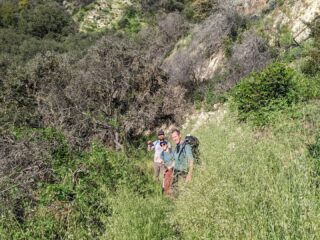
There are several crucial words here: in the past, there was confusion about who the Camp was for (most trail guides perpetuated the idea it was only for church groups.) In fact, the Camp has always been under a public use permit from the U.S. Forest Service. Even when ol’ Wilbur first put up some tents, the Camp was and is on public land.
So, the purpose identifies who ‘receives the benefit’ or results of the Conservancy’s work, which is the Public!
In this same mode, “stewardship” is a vitally important word; as members of the Board, we collectively and individually understand ourselves to be only temporary caretakers of the Camp for the generations hiking now, and those to come long after we any one of us have laced up our boots for the last time.
Of course, there are many more layers of meaning and motivation beyond the legal purpose statement – but those are for another newsletter another day!
Commentary: Risk, Liability, and Generations
By Gary Keene, President /General Manager
There was an interesting convergence in my reading this past week: first was a string of emails moving toward a new general liability insurance policy for the Conservancy/Camp. Like every other engagement with the ‘world down the Canyon’, there was a lot of explaining to people who simply could not grasp that there’s a place that people go where there’s no road, no wi-fi, and a nearly nine-mile round-trip hike—that you would do on purpose!
The question of insurance itself, of “risk management” amplified the disconnect: one of the questions was, “Are there trees near the buildings?” DUH. “What are the principal hazards of the campground?” Umm, rocks, roots, snakes, bears, cougers—and other campers!
From the perspective of insurance, all of these are negatives, hazards to be mitigated. Yet from the perspective of potential hikers and guests, these are not only attractions, they are also essential to the experience of being in the wilderness. Take away the trees, rocks, stream and critters and you might as well hike in a parking lot.
But that would be very safe, which has become a high priority for many. As David Brooks writes, “Gen Z-ers grew up with hypercautious parenting that exaggerates the dangers in life,” with the result that kids are more fearful and less adventurous. (“What Our Toxic Culture Does to the Young”. May 4, 2023, New York Times.)
He quotes from Dr. Jean Twenge’s new book “Generations”, which piles up research about the distinctive characteristics of Boomers, Millenials, Gen Z, etc. Coincidentally, I had just finished reading an extensive article by her coinciding with this new book, and Brooks and Twenge together reminded me of the Richard Louv’s groundbreaking 2005 book, “Last Child in the Woods: Saving Our Children from Nature-Deficit Disorder”.
That title says everything there is to know about the contents, and it also makes the case for the inherent purpose of the Sturtevant Conservancy: Camp is the antidote to both fear and the ‘nature-deficit disorder’.
While our legally stated non-profit purpose names the Camp, the Camp is only a tool for the deeper purpose of giving people a place in the outdoors to experience true wilderness. This is especially true for families of all kinds and their kids. When the Camp was acquired by the Methodist Church in 1947, it was envisioned as an introduction to real wilderness for elementary youth and teens. The bathhouse sinks were set low for kids, and every summer there were hiking camps that prepped youngsters for more serious backpacking in the Sierras once they were in high school.
Wilbur Sturtevant knew intimately the virtues of wilderness back in 1893 and built a business serving others who also appreciated those virtues and wanted that experience. The Conservancy continues on that path, with a special interest in giving kids direct (risky!) exposure to the very real and non-virtual, wi-fi free environment of the National Forest.
We’re confident that the folks who’ve been to Camp, have volunteered there and love hiking, “get this” about the value of the Camp. You know how unique it is, not just historically, but right now today: that we need to be more in touch with reality and all its scratchy, scraped-knee consequences. And in the face of global climate change, that we need to be personally in touch with the earth as it is, not just in photos and documentaries.
The real risk for any generation is to grow up out of touch with the essential gift of the earth: there is no policy to insure against that, only the practice of putting boots to dirt and eyes to the sky and beyond.
